Crustaceans are increasing their popularity among aquarists every year. First of all, this, of course, is due to the wide distribution of shrimps, but the “older” brothers in the class – large crayfish with beautiful natural color or obtained as a result of selection – breathe in the back. In this article, we will talk about the Florida blue crayfish. You will learn about the peculiarities of keeping, feeding, and breeding these beautiful crustaceans.
General information
Florida blue crayfish (Procambarus alleni) is a freshwater crustacean from the Cambaridae family. As the name suggests, the natural range of these arthropods is in the state of Florida (USA). However, the natural color of these crayfish is brown, but we will talk about one of the breeding farms that have become widespread among amateurs. Unlike their ancestors, these crayfish are colored deep blue.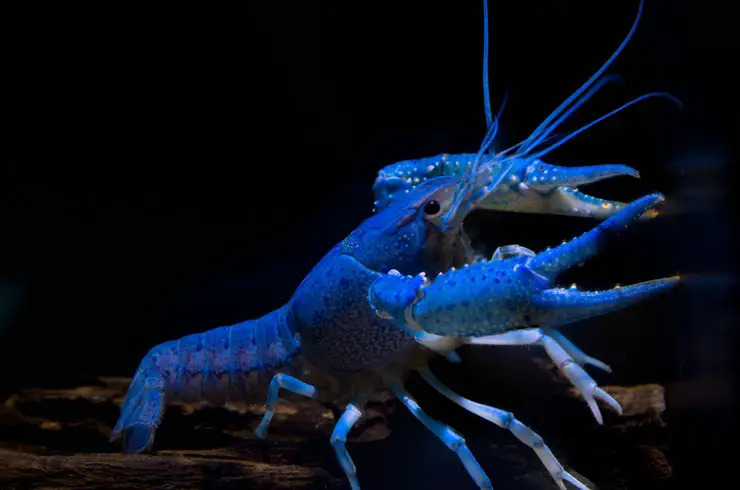
The blue color is associated with a defect in one of the genes, which is recessive in these invertebrates and does not manifest itself in the presence of the dominant “brown” gene. For the first time, blue forms were obtained in the United States through long and persistent breeding work.
Currently, Florida blue crayfish live in aquariums and are bred all over the world. They are not particularly picky about the content and are perfect for aquarists who wish to own an unusual underwater inhabitant. Unless you need a separate aquarium, keeping is conditionally possible only with some fish.
Appearance
If you have ever seen any crayfish, then you can easily imagine blue Florida. The front part of the body is the cephalothorax, covered with a dense scutellum (carapace), the back is the abdomen, consisting of segments and ending in a caudal fin. There are five pairs of walking legs, the first of which forms powerful claws. On the head are the senses – eyes, antennae, and antennae, and below there are several pairs of jaws.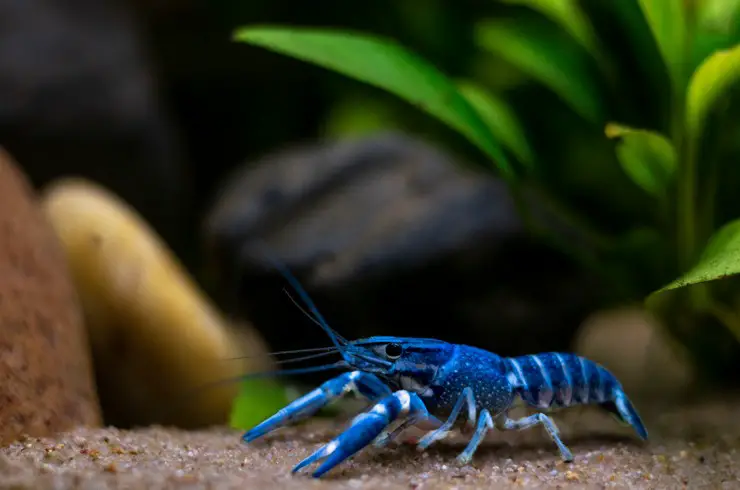
Florida crayfish are characterized by pronounced gender dimorphism, which manifests itself when they reach 3 cm in length. The abdomen in males is higher and elongated, the pincers are wider at the base and longer than in females. If you turn the male over on his back, then on the abdomen you can find a copulatory organ – gonopodium, which serves to fertilize the female. Females of Florida blue crayfish grow up to 9-10 cm in length, males – a couple of centimeters less.
The main value of this species is its amazing body color. It is deep blue, sometimes with purple hues.
The life span of Florida blue crayfish is 5-7 years.
Habitat
In the natural environment, this type of crustacean (but only with natural brown color) can be found in the state of Florida (USA). Crayfish live in slow-flowing and stagnant water bodies: lakes, streams, swamps, ponds. They prefer a soft muddy bottom, in which they like to dig tunnels. Here they get their main food – detritus.
Natural individuals are rather shy and, with any signs of danger, they burrow into the ground. Aquarium crayfish lose their fears and sometimes behave quite cheekily.
Care and maintenance
To keep a pair of adult Florida crayfish, an aquarium of 100 liters or more is recommended. Since these animals spend all their time at the bottom, it is not bad if it has the maximum area.
As for the soil, it is best to use coarse pebbles, which can be alternated with sandy areas. It is very important to provide plenty of covers. Their role can be played by grottoes, driftwood, halves of coconuts, ceramic pots. Florida blue crayfish are predominantly nocturnal, preferring to hide in shelters during the day.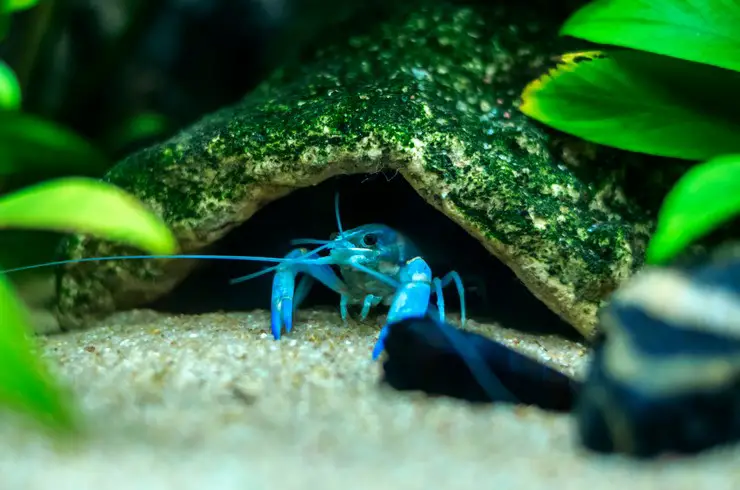
Unfortunately, live plants are not compatible with Florida crayfish. Even the most persistent of them (for example, anubias) will sooner or later be plucked. Therefore, it is more advisable to use artificial plants.
Despite the fact that in nature, Florida crayfish live in swamps and ponds, they prefer clean and well-aerated water, so a productive filter and compressor will be needed in an aquarium. To exclude the accumulation of toxic nitrogenous compounds to which crayfish are sensitive, you should change up to 20% of the volume of the aquarium once a week.
A special period in the life of blue Florida crayfish is molting. To grow, they regularly shed their old chitinous cover and grow in size until the new one hardens. At this time, animals are most vulnerable, because soft covers can damage even non-aggressive fish, not to mention relatives. Crayfish prefer to wait out molt in burrows or shelters. The frequency of the change in the old cover depends on the age of crayfish. Young individuals molt almost every week, adults – much less often. Surprisingly, thanks to molting, crayfish are able to restore lost limbs.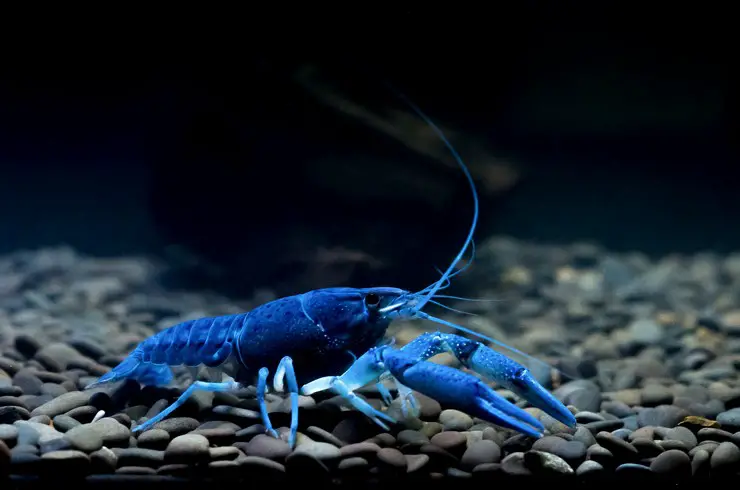
In order for the molt to pass without unnecessary excesses, the water in the aquarium must be hard enough (a source of calcium for the shell). It is useful to add conditioners containing iodine (Tetra Vital) to the water, a deficiency of which can lead to a violation of molting and death of crayfish.
Optimum water parameters for the content: T = 20-25 ° C, pH = 6.5-8.0, GH = 10-25.
Compatibility
The long-term experience of aquarists shows that keeping crayfish in a species aquarium is the best option. There are a number of reasons for this. If we put crayfish to large aggressive species, then the animal will become fearful, will rarely appear, and, therefore, starve. After molting, crayfish can be easily eaten. Considering small fish as neighbors, we inevitably encounter the hunting instincts of blue Florida crayfish, which will not give up trying to catch a swimming neighbor.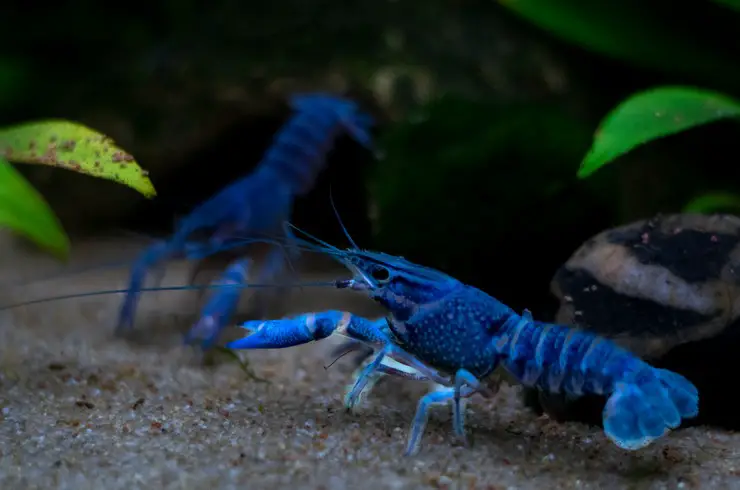
Intraspecific aggression is very strongly manifested in crayfish. Therefore, it is not recommended to keep several males in one aquarium. This will help avoid unnecessary fights and loss of limbs.
Feeding the blue Florida crayfish
Florida blue crayfish are typical detritivores, that is, animals that eat almost any organic matter that they can find at the bottom, such as plant leaves and dead fish. Thus, crustaceans are real orderlies of the bottom. If the opportunity presents itself, crayfish can grab small fish.
